 https://www.mypinio.com/wp-content/uploads/2023/02/How-to-find-promo-codes-easily.jpg
788
1400
mypinio
https://mypinio.com/wp-content/uploads/2022/04/mypinio_logo-1.png
mypinio2023-02-13 12:03:402023-02-13 12:06:15Promo Code: This is how easy you can find them to save money
https://www.mypinio.com/wp-content/uploads/2023/02/How-to-find-promo-codes-easily.jpg
788
1400
mypinio
https://mypinio.com/wp-content/uploads/2022/04/mypinio_logo-1.png
mypinio2023-02-13 12:03:402023-02-13 12:06:15Promo Code: This is how easy you can find them to save money10 January 2023 [xyz-ips snippet=”CATEGORYLINK”]
CONTENT
- 1 Why do people attribute symbolism and meanings to flowers?
- 2 What meanings and symbols do flowers have?
- 2.1 Here are a few examples of the different meanings and symbolism flowers do have
- 2.1.1 Symbolism and meaning of the rose: love, affection, beauty, resistance
- 2.1.2 Symbolism and meaning of the tulip: love, passion, spring, renewal, appreciation
- 2.1.3 Symbolism and meaning of the carnation: purity and innocence, but also devotion
- 2.1.4 Symbolism and meaning of the lily: purity, dignity, innocence
- 2.1.5 Symbolism and meaning of the iris: beauty, courage and strength
- 2.1.6 Symbolism and meaning of the orchid: pride, love, affection, beauty, refinement.
- 2.1.7 Symbolism and meaning of the sunflower: fertility, security, beauty, light, life
- 2.1.8 Symbolism and meaning of lavender: peace, relaxation, sensuality, but also mourning and death.
- 2.1.9 Symbolism and meaning of jasmine: beauty, love, passion, romance and also spirituality.
- 2.1.10 Symbolism and meaning of the lily of the valley: youth, innocence, spring, new life, but also remembrance.
- 2.1.11 Symbolism and meaning of the daisy: naivety, innocence, purity, youth.
- 2.1.12 Symbolism and meaning of the anemone: transience, death and mourning
- 2.1.13 Symbolism and meaning of the peony: love, romance, affection
- 2.1.14 Symbolism and meaning of the chrysanthemum: commemoration, perfection, immortality
- 2.1.15 Symbolism and meaning of the dahlia: courage, strength, endurance, dignity
- 2.1.16 Symbolism and meaning of the geranium: joy and confidence
- 2.1.17 Symbolism and meaning of the gladiolus: courage, strength, grace
- 2.1.18 Symbolism and meaning of the daisy: innocence and purity, confidence, hope.
- 2.1.19 Symbolism and meaning of the violet: “I am thinking of you”.
- 2.1.20 Symbolism and meaning of the primrose: youth and innocence, gratitude
- 2.1 Here are a few examples of the different meanings and symbolism flowers do have
- 3 Give a bouquet of flowers as a gift: This keeps flowers in the vase fresh and durable for longer. Tips for a long flower life!
- 3.1 Tip 1: Alway use clean water
- 3.2 Tip 2: Remove wilted flowers and leaves
- 3.3 Tip 3: Use citric acid or aspirin
- 3.4 Tip 4: Cutting the stems at an angle
- 3.5 Tip 5: Put the vase in a cool place
- 3.6 Tip 6: Add sugar or honey to the flower water
- 3.7 Tip 7: Do not place the vase near fruits
- 3.8 Tip 8: Heating air and air conditioners make flowers wilt faster
- 4 Vouchers for plants and flowers
Why do people attribute symbolism and meanings to flowers?
Flowers have had symbolic meanings for centuries, finding uses in culture, literature, art and also in everyday life. The association of certain flowers with certain events, feelings and characteristics can be traced back to various origins, such as religious or mythological traditions, folklore or cultural customs. By assigning certain meanings to flowers, people can communicate in a way about their feelings and thoughts. Flowers are also often used as gifts to express feelings such as joy, gratitude, sadness or apology.
Example of the symbolism and meaning of flowers
An example of the emergence of symbolic meanings for flowers is the use of lilies at funerals, which may be due to the symbolic meaning of innocence and purity. Another example is the use of roses as a symbol of love, also in poetry and literature. In Germany, during the Nazi period, the white rose was used as a symbol of resistance against the Nazi regime. The white rose was the symbol of a student group that began distributing leaflets against the regime in 1942. The members of this group, consisting of siblings Hans and Sophie Scholl and their friends, believed that it was their duty as Germans to protest against the injustice and oppression perpetrated by the Nazis. Today, the white rose is a symbol of the courage to stand up against oppression and injustice, and of the need to stand up for truth and justice.
The colour of flowers can also have a symbolic meaning. In many cultures, red is considered a symbol of love and passion, while white is considered a symbol of innocence and purity. Blue, on the other hand, often represents fidelity and dignity.
The symbolic use of flowers can also come from the association of flowers with certain events and personalities. For example, the calla lily is often associated with the artist and designer Alexander McQueen, as he often used it in his artistic work.
Overall, it can be said that the use of flowers as symbols and their meanings are deeply rooted in history and culture, and in many cases are due to the association of certain events, feelings and characteristics with specific flowers.
These symbolic meanings of flowers have changed and adapted over time and often reflect the values and culture of a society. By assigning certain meanings to flowers, people can communicate about their feelings and thoughts in a way that is deeply rooted in the art, literature and culture of their society.
What meanings and symbols do flowers have?
The colours and shapes of flowers provide visual pleasure and can enliven the spirit. A bouquet of flowers can also be presented as an expression of affection and care when someone is particularly interested in and appreciative of another person. In some cultures, flowers also play an important role in special occasions such as weddings or funerals, and a bouquet can be given in such cases as a sign of compassion or support. It also depends on the meanings behind the gift, for example red roses could be given as a sign of love or lilies as a sign of purity and innocence. Overall, there are many reasons why people might enjoy a bouquet of flowers. It depends on the personal preferences of the flowers and the meaning of the gift.
Here are a few examples of the different meanings and symbolism flowers do have
Symbolism and meaning of the rose: love, affection, beauty, resistance
The rose is probably the best known flower and is often used as a symbol of love and passion. However, the rose is a flower with many other symbolic meanings. It is often used as a symbol of affection, especially when given as a gift. A red rose is considered a symbol of romantic love, while a white rose is considered a symbol of purity and innocence. The rose is also often used as a symbol of beauty and grace and frequently as a metaphor in works of art and literature. In the Christian tradition, the rose is also considered a symbol of the Holy Spirit and the resurrection of Jesus. Incidentally, the White Rose was the name of a group of students and professors at the University of Munich during National Socialism in Germany. The group stood up against the Nazi regime and distributed leaflets calling for resistance and denouncing the crimes of the regime.

The rose is the symbol of love, affection and beauty.
Symbolism and meaning of the tulip: love, passion, spring, renewal, appreciation
The tulip is also a flower with high symbolic meaning. In many cultures, the tulip is considered a symbol of love, appreciation and passion. In Dutch culture, the tulip is particularly popular and is often given as a gift for Mother’s Day or other occasions. The tulip is also often used as a symbol of spring and new beginnings, as it is often one of the first flowers to bloom again after winter. In the Christian tradition, the tulip is also seen as a symbol of life after death. It is also often picked at Easter and can be seen as a sign of renewal.
Symbolism and meaning of the carnation: purity and innocence, but also devotion
The carnation is a small, colourful flower that is often used as a symbol of remembrance, sacrifice and loyalty. The carnation shows how different meanings and symbolism for flowers can be. It is also given as a sign of appreciation and affection. In some cultures, the carnation is also seen as a symbol of purity and innocence. In the Christian tradition, the carnation is a symbol of the Passion of Jesus and is often used during Holy Week. But it can also be associated with devotion.
Symbolism and meaning of the lily: purity, dignity, innocence
The lily is a beautiful flower that is often used as a symbol of purity, innocence and dignity. It is also often used at weddings and other festive occasions. It is also often considered a symbol of the Madonna figure in Christian mythology. In art and literature, the lily has often been used as a symbol of immortality and resurrection. In some cultures, the lily is also considered a symbol of fertility and abundance.
Symbolism and meaning of the iris: beauty, courage and strength
The iris is a popular ornamental plant that is common in many parts of the world. It has long, green stems and beautifully shaped, colourful flowers that come in a variety of colours including purple, blue, yellow and white. In many cultures, the iris has symbolic meanings relating to beauty, courage and strength. It is also often considered a symbol of the goddess Iris in Greek mythology, who served as a messenger between humans and the gods. In art and literature, the iris has often been used as a symbol of hope and inspiration. In some cultures, the iris is also considered a symbol of the soul and intelligence.
Symbolism and meaning of the orchid: pride, love, affection, beauty, refinement.
The orchid is an exotic flower that is common in many parts of the world. It has long, green stems and beautifully shaped, colourful flowers that come in a variety of colours including pink, purple, white and red. In many cultures, the orchid has symbolic meanings relating to beauty, sophistication and luxury. It is also often seen as a symbol of love and affection and is often used as a gift on special occasions such as weddings and Valentine’s Day. In art and literature, the orchid has often been used as a symbol of the exotic and the mysterious. Also for pride. In some cultures, the orchid is also considered a symbol of femininity and fertility.
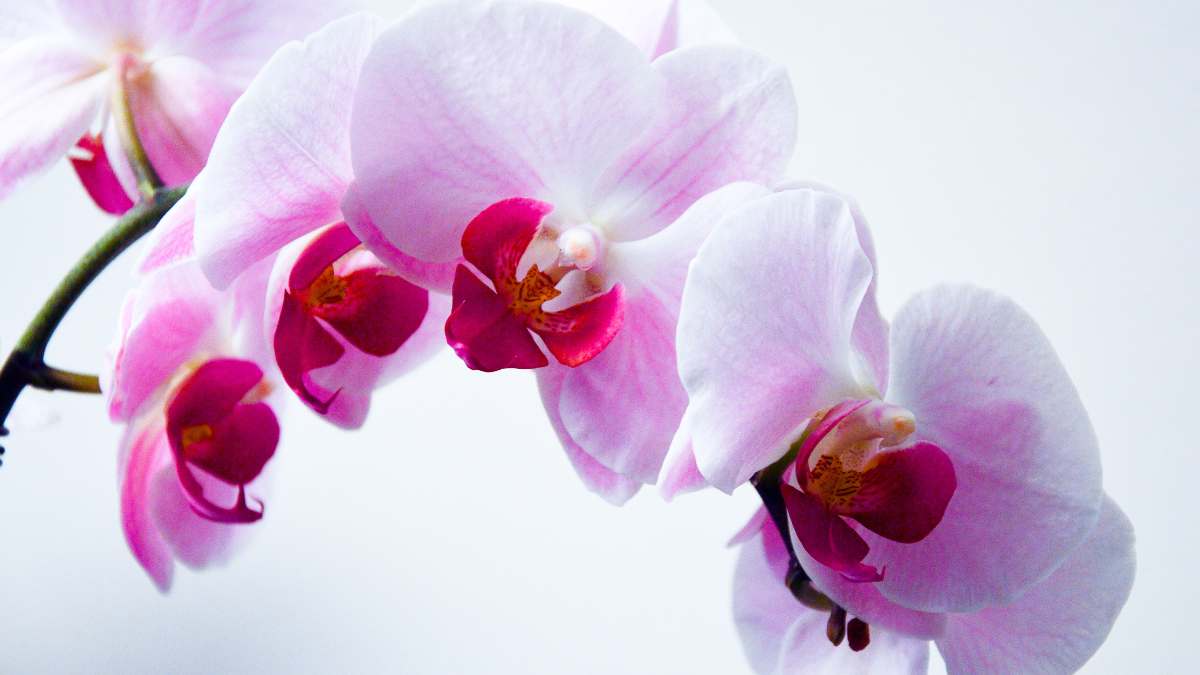
The orchid is a beautiful flower that stands for pride and beauty. It is one of the world’s most popular flowers and its meaning and symbolism is often included in literature, poetry and art.
Symbolism and meaning of the sunflower: fertility, security, beauty, light, life
The sunflower is a cheerful flower that is most common in the warm climates of the world. The sunflower is probably one of the most popular flowers of all! It has large, golden-yellow flowers that follow the sunlight and green, rough-haired stems and leaves. In many cultures, the sunflower has symbolic meanings that relate to joy, happiness and vitality. It is also often seen as a symbol of the sun and light and is often used as a sign of warmth and security. In art and literature, the sunflower has often been used as a symbol of beauty and innocence in nature. In some cultures, the sunflower is also considered a symbol of fertility and abundance.
Symbolism and meaning of lavender: peace, relaxation, sensuality, but also mourning and death.
Lavender is a popular ornamental plant that is native mainly to Mediterranean countries. It has long, green stems and small, purple or violet flowers that exude a fragrant scent. In many cultures, lavender has symbolic meanings that refer to tranquillity, relaxation and purity. It is also often considered a symbol of fidelity and honesty. In literature, lavender has often been used as a symbol of loneliness and sadness. In some cultures, lavender is also considered a symbol of death and mourning, as its scent is often used in connection with funerals and memorial services.
Symbolism and meaning of jasmine: beauty, love, passion, romance and also spirituality.
Jasmine is a popular ornamental plant that is common in many parts of the world. It has green, climbing stems and white or yellow, fragrant flowers. In many cultures, jasmine has symbolic meanings relating to beauty, love and passion. It is also often considered a symbol of romance and falling in love. In some cultures, jasmine is also considered a symbol of purity and innocence. In literature, the jasmine plant has often been used as a symbol of the feminine and desire. In yet other cultures, it is also considered a symbol of prayer and spirituality.
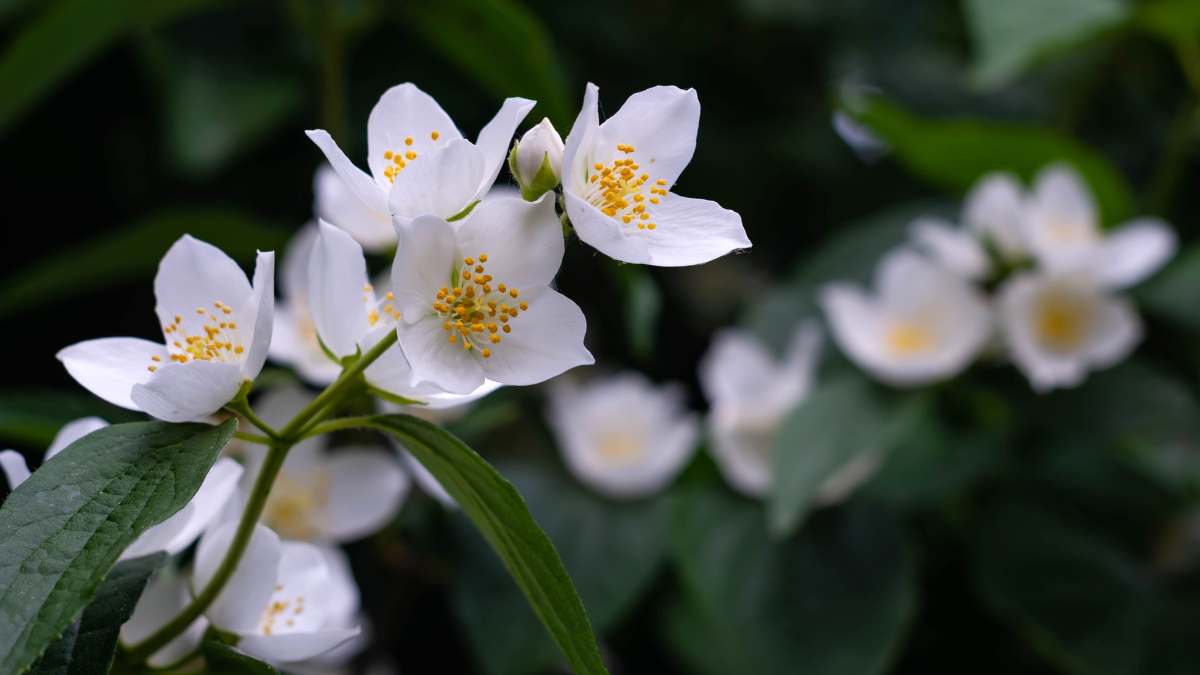
Jasmine stands for beauty, love, passion, romance and also spirituality.
Symbolism and meaning of the lily of the valley: youth, innocence, spring, new life, but also remembrance.
The lily of the valley is a popular ornamental plant that flowers mainly in spring. The lily of the valley has long, green leaves and white or pink, bell-shaped flowers. In many cultures, the lily of the valley has symbolic meanings relating to beauty, youth and innocence. It is also often seen as a symbol of the return of spring and new life. In some cultures, the lily of the valley is also considered a symbol of death and mourning, as its flowers are often used in connection with funerals and memorial services.
Symbolism and meaning of the daisy: naivety, innocence, purity, youth.
The daisy is a small, herbaceous plant that is common in many parts of the world. It has small, star-shaped flowers that are often white, yellow or red. The daisy has various symbolic meanings in different cultures and in literature. In some cultures, the daisy is considered a symbol of innocence, purity and naivety. It is also seen as a symbol of youth and the beauty of nature. In literature, the daisy has often been used as a symbol of oppression and strength, being able to survive and flower despite difficult conditions.
Symbolism and meaning of the anemone: transience, death and mourning
The anemone is a plant species found in many parts of the world. It usually grows as a small, herbaceous plant and has flowers in different colours, often white, pink or purple. The anemone has many different meanings. It is often used as a symbol of transience, weariness and innocence, but it is also seen as a sign of sympathy and compassion, a symbol of beauty, hope and innocence. In other cultures, the anemone is also seen as a symbol of birth and life. In Roman mythology, however, the anemone was considered a symbol of death and mourning. In the modern world, the anemone is often used as an ornamental plant and is also a popular choice for flower arrangements.
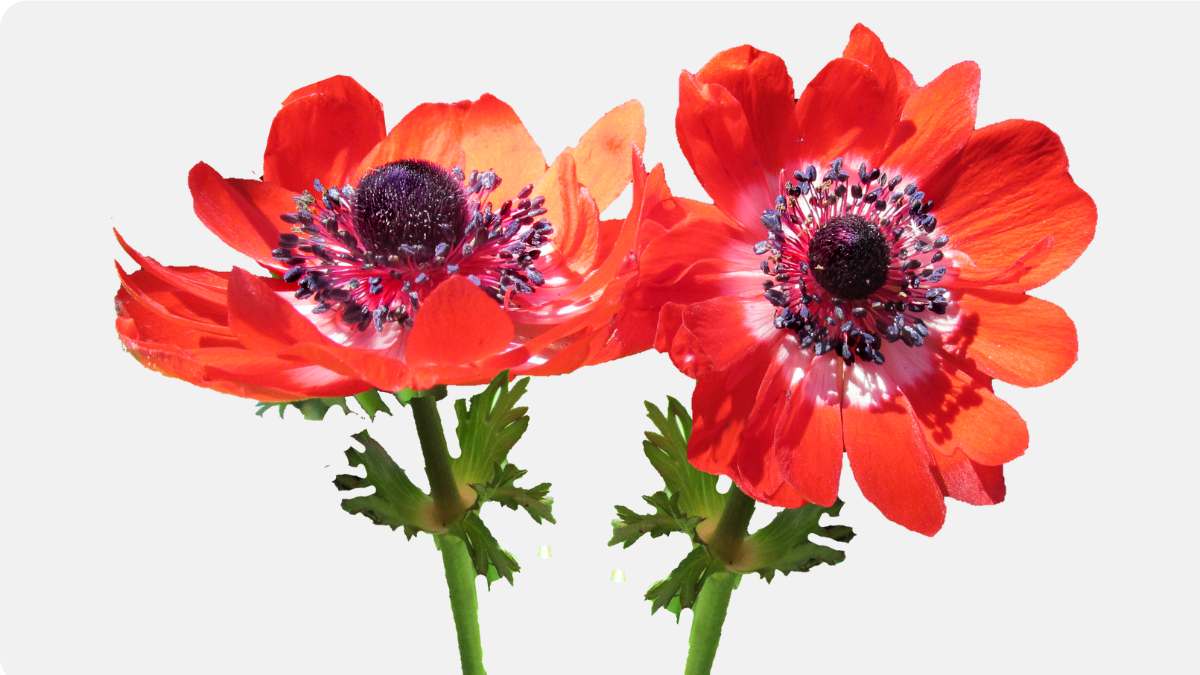
Despite its unmistakable beauty, the anemone stands for transience, death and mourning in many cultures.
Symbolism and meaning of the peony: love, romance, affection
The peony, often called the bleeding heart, is a flower native mainly to Europe and North America. It is often planted as an ornamental plant in gardens because of its large, showy flowers. In some cultures, the peony is considered a symbol of love and romance. The peony is also considered a symbol of the feast of Pentecost, which is celebrated in the Christian tradition and commemorates the work of the Holy Spirit in the Church. It is also often used as a sign of friendship and affection.
Symbolism and meaning of the chrysanthemum: commemoration, perfection, immortality
The chrysanthemum is a plant that is particularly popular in Japan, where it is a symbol of autumn. The chrysanthemum is also known as the peace flower, as it is traditionally used in Japan on memorial days for the deceased. In other parts of the world, the Chrysanthemum is mainly popular as an ornamental plant in gardens and parks. It comes in many different colours and sizes and is often used as a cut flower. In some cultures, the Chrysanthemum is also regarded as a symbol of immortality and perfection.
Symbolism and meaning of the dahlia: courage, strength, endurance, dignity
The dahlia is a flower that belongs to the composite family (Asteraceae). It is popular mainly because of its colourful flowers and is often planted in gardens and parks. The dahlia originates from Central and South America and was introduced to Europe by Spanish conquerors in the 16th century. In some cultures the dahlia is seen as a symbol of courage, strength and endurance or the meaning is honesty and dignity, independence. It is also a popular motif in works of art and is often used in flower arrangements.
Symbolism and meaning of the geranium: joy and confidence
The geranium is a popular ornamental plant that belongs to the passion flower family (Passifloraceae). In symbolism, the geranium often stands for joy, confidence and support. In the language of flowers, the geranium can also carry the statement “I’m thinking of you” or “I miss you”. The geranium is also known as a sign of attachment and goodwill, signifying friendship and solidarity.
Symbolism and meaning of the gladiolus: courage, strength, grace
The gladiolus is a striking flower that is often used as a symbol of courage, strength and grace. It is also often used in funeral services as it is seen as a sign of devotion and respect. The gladiolus is a flowering plant that belongs to the iris family and originates from South America. It grows upright and has long, narrow leaves and large, variegated flowers that can come in many different colours, such as red, orange, yellow, white and purple. The gladiolus is often planted in gardens and on terraces and looks good in vases and as a cut flower.
Symbolism and meaning of the daisy: innocence and purity, confidence, hope.
In the language of flowers, the daisy stands for innocence and purity. It is associated in some cultures as a symbol of childlikeness or innocence, and with innocent love. The daisy is also a sign of confidence and hope. In many parts of the world, the daisy is also considered a lucky flower and as such is used in many different occasions. So it is always a good occasion to give daisies as a gift and to tie them in a bouquet with other flowers.
Symbolism and meaning of the violet: “I am thinking of you”.
The violet is a plant that belongs to the violet family (Violaceae). In symbolism, the violet is often associated with humility, modesty and innocence. In the language of flowers, it can also carry the message “I’m thinking of you” or “I miss you”. So if you want to give flowers to someone you miss very much, violets are the way to go! In some cultures, the violet is also considered a good luck charm. There are many different types of violets, which come in different colours and shapes.
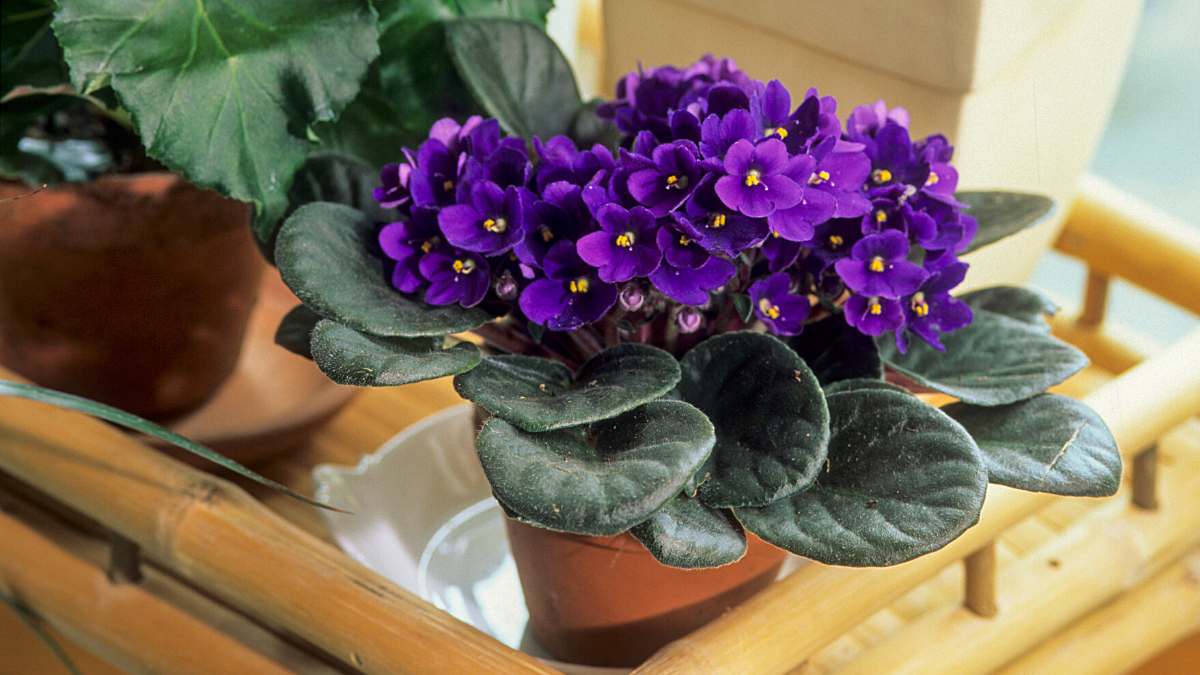
If there is a surprise flowerpot of violets on your desk, it means someone misses you or is thinking of you.
Symbolism and meaning of the primrose: youth and innocence, gratitude
The primrose is a popular ornamental plant that belongs to the primrose family (Primulaceae). In symbolism, this flower, which exists in more than 500 different species and in all imaginable colours, stands for youth and innocence. In the language of flowers, the primrose is also known as a sign of friendship, respect and sincere thanks.
You see, flowers have very different meanings and the symbolism can vary from culture to culture! Therefore, it is important that the person receiving the gift knows the meaning, or that you explain it to them when you give them the bouquet. After all, there are people who are not familiar with the symbolism and meaning of flowers and do not understand the message behind the flower gift at all. Nevertheless, it is always a good idea to give flowers as a gift, because there is hardly anyone who does not like flowers, even if the meaning and symbolism are not understood. In the end, flowers are simply very beautiful to look at and bring joy. And to ensure that flowers last a long time, here are a few tips on how to keep them fresh and durable for longer in the vase.
Give a bouquet of flowers as a gift: This keeps flowers in the vase fresh and durable for longer. Tips for a long flower life!
Flowers are a symbol of beauty and vitality in many cultures, and a bouquet of flowers can be a joy to give as a gift and a kind gesture. Some people also have a personal preference for certain types of flowers and are therefore particularly happy to receive a bouquet of their favourite flowers. A bouquet of flowers can also be given as a token of appreciation or recognition, for example as a thank you or for a birthday. A bouquet of flowers can also help to beautify a room and create a pleasant atmosphere. Therefore, it is important to ensure that flowers and bouquets stay fresh and durable for a long time. Here are a few valuable tips.
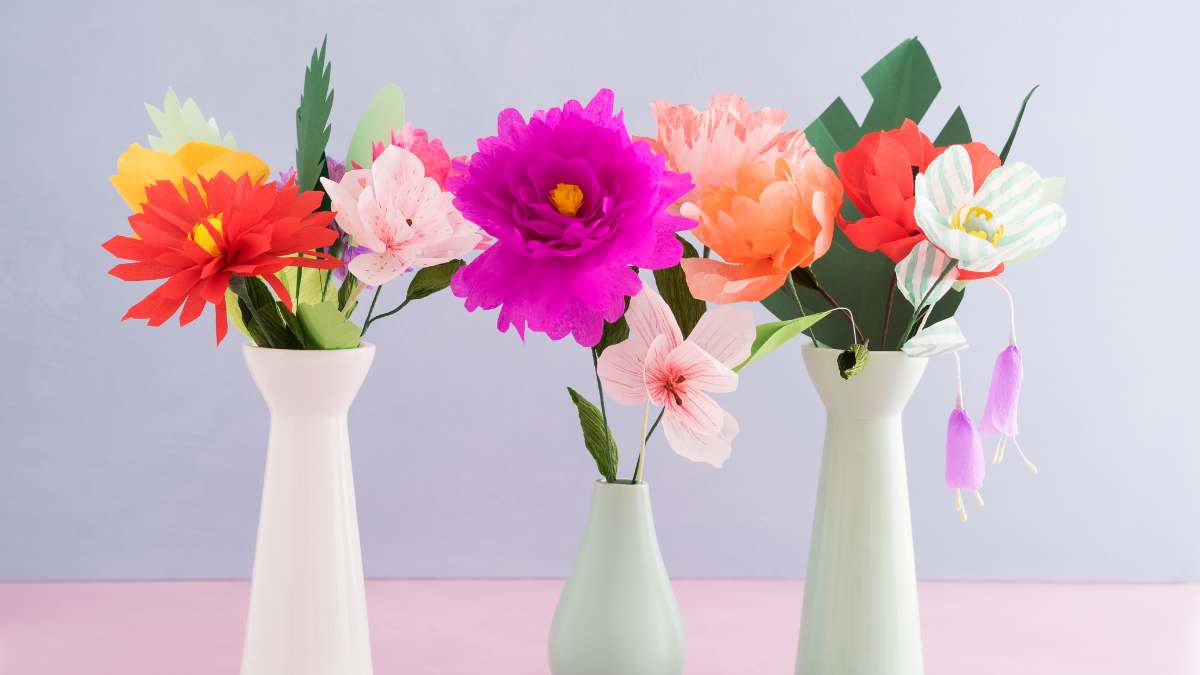
Anyone who receives flowers as a gift wants them to last a long time and stay fresh in the vase. The following tips will help you to enjoy your flowers for a long time.
Tip 1: Alway use clean water
It is important to use clean water in the vase and change it regularly to prolong the shelf life of flowers. If the water in the vase is dirty, decay products and bacteria can accumulate, causing the flowers to wilt more quickly. It is also important to clean the vase thoroughly before using it again to ensure that it does not contain bacteria that could damage the flowers. You can also enrich the water with special flower food products to keep the flowers fresh for longer.
Tip 2: Remove wilted flowers and leaves
It is also important to remove wilted flowers and leaves from the stems to prevent them from taking nutrients away from the other flowers and releasing decomposition products. If wilted flowers and leaves remain on the plants, they can deprive the plants of energy and nutrients they need for growth and flowering. It is therefore important to remove them regularly to promote flower longevity.
Tip 3: Use citric acid or aspirin
Adding citric acid or aspirin to the water can help keep the water clean and extend the shelf life of flowers in the vase. The citric acid helps prevent the growth of bacteria in the water, while aspirin has a preservative effect and can help keep flowers fresh for longer. However, it is important to note that these substances should be used in small quantities so as not to damage the flowers.
Tip 4: Cutting the stems at an angle
Almost everyone knows this tip: cutting the stems at an angle helps the flowers to absorb water more easily and prolongs their shelf life in the vase. Sharp scissors or a knife should be used to avoid damage to the stems and to ensure that the flowers can absorb enough water. It is also important to make sure that the stems are not cut too short, otherwise they may not be able to absorb enough water.
Tip 5: Put the vase in a cool place
To prevent flowers from wilting quickly, the tip of placing the vase in a cool place and protecting it from direct sunlight helps to prolong the life of the flowers. Too much heat and light can cause the flowers to fade more quickly.
Tip 6: Add sugar or honey to the flower water
It is also a good tip that adding sugar or honey to the water in the flower vase can help the flowers stay fresh and last longer. This is because sugar is a concentrated source of energy for the flowers, which can help them survive longer. However, care should be taken not to add too much sugar or honey as this can lead to mould and even damage the flowers. It is therefore advisable to use only a small amount and to change the water regularly to ensure that the flowers get enough fresh water and nutrients.
Tip 7: Do not place the vase near fruits
Avoid placing flowers near fruit as the ethylene gases given off by fruit can shorten the shelf life of flowers.Ethylene is a naturally occurring gas given off by some fruits and vegetables and can help flowers wilt faster. It has been shown that the shelf life of flowers, especially roses, is shortened if they are placed near fruit that emits ethylene. Therefore, it is a really good tip to keep flowers away from fruit to extend their shelf life and freshness. However, there are some fruits and vegetables that give off no or very little ethylene, such as avocado, lemons, pineapple and papaya. So these can be kept near flowers without it affecting their shelf life.
Tip 8: Heating air and air conditioners make flowers wilt faster
Avoid placing flowers near heaters or air conditioners as these can produce dry air which will cause the flowers to fade more quickly. Heaters and air conditioners usually produce dry air that is not good for the flowers. If the air is too dry, the flowers can wither faster and their petals can dry out and wilt. Therefore, it is better to keep the flowers away from heaters and air conditioners and place them in a cooler, more humid place instead. A tip for this: If the air in the home is very dry, it can also be helpful to place a bowl of water near the flowers to increase the humidity.

Flowers bring joy! With mypinio you can earn vouchers and redeem them for flowers and plants. Or for accessories in many online shops.
Vouchers for plants and flowers
Now nothing stands in the way of floral happiness! You now know the meaning and symbolism of flowers and you have an idea of how to keep the flowers in the vase fresh and durable for longer. To treat yourself to a few extra flowers or plants, or if you want to give flowers to someone dear to you, you can now easily earn vouchers that you can redeem for flowers and plants. Simply register with mypinio, the reputable community for paid surveys, complete a few surveys and earn vouchers for your favourite flowers and plants.
You can also invite your friends to mypinio and network with them in our community and exchange tips and tricks on the topic of flowers and plants and how to care for them, how to keep them fresh and durable for longer!
Write us your opinion in the comments too.
→ Click here to go to the comments
read also
#paidsurveys #livepolls #premiummember★ #earnmoney #ikeavouchers #ebayvouchers #gamingvouchers #amazonvouchers
[shariff]
Keywords of this blog post
Flowers | Shelf life | Keep fresh | Meaning | Symbolism | Vouchers




